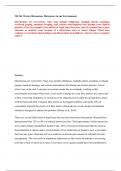Samenvatting
Summary Work Psychology
- Instelling
- Tilburg University (UVT)
This summary has the following components: - all lectures including 3 guest lectures given in 2024 - 3 workgroup papers This means that the book isn't in the summary, but it is not needed to pass the course. Another thing that is 'missing' is a further explanation for the paper by "Kegan & Lahey...
[Meer zien]













